Evaluation of the Ecological Effects of Ecological Restoration Programs: A Case Study of the Sloping Land Conversion Program on the Loess Plateau, China
Abstract
:1. Introduction
2. Materials and Methods
2.1. Study Area
2.2. Methodology
2.2.1. Land Use Transfer Matrix
2.2.2. Vegetation Fraction Cover
2.2.3. Trend Analysis of VFC
2.2.4. Soil Loss
- (1)
- Rainfall erosion factor (R)
- (2)
- Soil erosive factor (K)
- (3)
- Slope length and steepness factor (LS)
- (4)
- Vegetation cover and management factor (C)
- (5)
- Erosion control practice factor (p)
2.3. Data Sources
3. Results
3.1. Land Use Change
3.2. VFC Change
3.3. Soil Loss
4. Discussion
4.1. The Impact of SLCP on Ecological Effects
4.2. The Impact of Climatic Factors on the SLCP
5. Conclusions
- (1)
- From 2000 to 2018, the implementation of the SLCP on the Loess Plateau achieved remarkable ecological effects. In terms of the temporal impact of the SLCP on ecological effects, the SLCP has led to increases in the areas of forest land and grassland on the Loess Plateau. The area of grassland generally showed a decreasing trend, but the area of grassland showed a significant increasing trend in the core area of the SLCP. The increases in forest land and grassland consequently led to an increase in VFC and a decrease in soil erosion. In terms of the spatial impact of the SLCP on ecological effects, the slopes of 6–15° and 15–25° are the core areas for the implementation of the SLCP on the Loess Plateau, and the areas where each ecological effect was significantly improved are also concentrated there, mainly in the loess sorghum gully region and the loess hilly gully region.
- (2)
- Ecosystem improvements in the Loess Plateau from 2000 to 2018 were influenced by both the SLCP and climate change. The warming and humidification of the Loess Plateau climate tended to contribute, to a certain extent, to the implementation of the SLCP; precipitation had a greater impact on the vegetation changes on the Loess Plateau. At the same time, precipitation is also a dominant factor determining the spatial differentiation of vegetation on the Loess Plateau.
Author Contributions
Funding
Institutional Review Board Statement
Informed Consent Statement
Data Availability Statement
Acknowledgments
Conflicts of Interest
References
- Posner, S.M.; McKenzie, E.; Ricketts, T.H. Policy Impacts of Ecosystem Services Knowledge. Proc. Natl. Acad. Sci. USA 2016, 113, 1760–1765. [Google Scholar] [CrossRef] [PubMed] [Green Version]
- Turner, W.R.; Brandon, K.; Brooks, T.M.; Costanza, R.; da Fonseca, G.A.B.; Portela, R. Global Conservation of Biodiversity and Ecosystem Services. BioScience 2007, 57, 868–873. [Google Scholar] [CrossRef] [Green Version]
- Xiao, H.; McDonald-Madden, E.; Sabbadin, R.; Peyrard, N.; Dee, L.E.; Chadès, I. The Value of Understanding Feedbacks from Ecosystem Functions to Species for Managing Ecosystems. Nat. Commun. 2019, 10, 3901. [Google Scholar] [CrossRef] [PubMed] [Green Version]
- Millennium ecosystem assessment. In Ecosystems and Human Well-Being; Island Press: Washington, DC, USA, 2005.
- Rockström, J.; Steffen, W.; Noone, K.; Persson, Å.; Chapin, F.S.; Lambin, E.; Lenton, T.M.; Scheffer, M.; Folke, C.; Schellnhuber, H.J.; et al. Planetary Boundaries: Exploring the Safe Operating Space for Humanity. Ecol. Soc. 2009, 14, 32. [Google Scholar] [CrossRef]
- Bryan, B.A.; Gao, L.; Ye, Y.; Sun, X.; Connor, J.D.; Crossman, N.D.; Stafford-Smith, M.; Wu, J.; He, C.; Yu, D.; et al. China’s Response to a National Land-System Sustainability Emergency. Nature 2018, 559, 193–204. [Google Scholar] [CrossRef]
- Cao, S. Impact of China’s Large-Scale Ecological Restoration Program on the Environment and Society in Arid and Semiarid Areas of China: Achievements, Problems, Synthesis, and Applications. Crit. Rev. Environ. Sci. Technol. 2011, 41, 317–335. [Google Scholar] [CrossRef]
- Liu, J.; Li, S.; Ouyang, Z.; Tam, C.; Chen, X. Ecological and Socioeconomic Effects of China’s Policies for Ecosystem Services. Proc. Natl. Acad. Sci. USA 2008, 105, 9477–9482. [Google Scholar] [CrossRef] [Green Version]
- Bennett, M.T. China’s Sloping Land Conversion Program: Institutional Innovation or Business as Usual? Ecol. Econ. 2008, 65, 699–711. [Google Scholar] [CrossRef] [Green Version]
- Uchida, E.; Xu, J.; Rozelle, S. Grain for Green: Cost-Effectiveness and Sustainability of China’s Conservation Set-Aside Program. Land Econ. 2005, 81, 247–264. [Google Scholar] [CrossRef]
- Xu, Z.; Bennett, M.T.; Tao, R.; Xu, J. China’s Sloping Land Conversion Program Four Years on: Current Situation and Pending Issues. Int. For. Rev. 2004, 6, 317–326. [Google Scholar] [CrossRef]
- Wang, S.; Yue, X. The Grain for Green Project, Non-farm Employment, and the Growth of Farmer Income. Econ. Res. J. 2017, 52, 106–119. [Google Scholar]
- Lu, G.; Yin, R. Evaluating the Evaluated Socioeconomic Impacts of China’s Sloping Land Conversion Program. Ecol. Econ. 2020, 177, 106785. [Google Scholar] [CrossRef]
- Wu, X.; Wang, S.; Fu, B.; Feng, X.; Chen, Y. Socio-Ecological Changes on the Loess Plateau of China after Grain to Green Program. Sci. Total Environ. 2019, 678, 565–573. [Google Scholar] [CrossRef] [PubMed]
- Deng, Y.; Cai, W.; Hou, M.; Zhang, X.; Xu, S.; Yao, N.; Guo, Y.; Li, H.; Yao, S. How Eco-Efficiency Is the Forestry Ecological Restoration Program? The Case of the Sloping Land Conversion Program in the Loess Plateau, China. Land 2022, 11, 712. [Google Scholar] [CrossRef]
- Liu, J.; Diamond, J. China’s Environment in a Globalizing World. Nature 2005, 435, 1179–1186. [Google Scholar] [CrossRef]
- Chao, W.; Lin, Z.; Bingzhen, D. Assessment of the Impact of China’s Sloping Land Conservation Program on Regional Development in a Typical Hilly Region of the Loess Plateau—A Case Study in Guyuan. Environ. Dev. 2017, 21, 66–76. [Google Scholar] [CrossRef]
- Li, J.; Li, Z.; Lü, Z. Analysis of Spatiotemporal Variations in Land Use on the Loess Plateau of China during 1986–2010. Environ. Earth Sci. 2016, 75, 997. [Google Scholar] [CrossRef]
- Tang, Y.; Shao, Q.; Liu, J.; Zhang, H.; Yang, F.; Cao, W.; Wu, D.; Gong, G. Did Ecological Restoration Hit Its Mark? Monitoring and Assessing Ecological Changes in the Grain for Green Program Region Using Multi-Source Satellite Images. Remote Sens. 2019, 11, 358. [Google Scholar] [CrossRef] [Green Version]
- Zhang, X.; Deng, Y.; Hou, M.; Yao, S. Response of Land Use Change to the Grain for Green Program and Its Driving Forces in the Loess Hilly-Gully Region. Land 2021, 10, 194. [Google Scholar] [CrossRef]
- Zhou, D.; Zhao, S.; Zhu, C. The Grain for Green Project Induced Land Cover Change in the Loess Plateau: A Case Study with Ansai County, Shanxi Province, China. Ecol. Indic. 2012, 23, 88–94. [Google Scholar] [CrossRef]
- Du, J.; Quan, Z.; Fang, S.; Liu, C.; Wu, J.; Fu, Q. Spatiotemporal Changes in Vegetation Coverage and Its Causes in China since the Chinese Economic Reform. Environ. Sci. Pollut. Res. 2020, 27, 1144–1159. [Google Scholar] [CrossRef] [PubMed]
- Jin, F.; Yang, W.; Fu, J.; Li, Z. Effects of Vegetation and Climate on the Changes of Soil Erosion in the Loess Plateau of China. Sci. Total Environ. 2021, 773, 145514. [Google Scholar] [CrossRef] [PubMed]
- Li, G.; Sun, S.; Han, J.; Yan, J.; Liu, W.; Wei, Y.; Lu, N.; Sun, Y. Impacts of Chinese Grain for Green Program and Climate Change on Vegetation in the Loess Plateau during 1982–2015. Sci. Total Environ. 2019, 660, 177–187. [Google Scholar] [CrossRef]
- Li, P.; Wang, J.; Liu, M.; Xue, Z.; Bagherzadeh, A.; Liu, M. Spatio-Temporal Variation Characteristics of NDVI and Its Response to Climate on the Loess Plateau from 1985 to 2015. CATENA 2021, 203, 105331. [Google Scholar] [CrossRef]
- Liu, Z.; Wang, J.; Wang, X.; Wang, Y. Understanding the Impacts of ‘Grain for Green’ Land Management Practice on Land Greening Dynamics over the Loess Plateau of China. Land Use Policy 2020, 99, 105084. [Google Scholar] [CrossRef]
- Shi, S.; Yu, J.; Wang, F.; Wang, P.; Zhang, Y.; Jin, K. Quantitative Contributions of Climate Change and Human Activities to Vegetation Changes over Multiple Time Scales on the Loess Plateau. Sci. Total Environ. 2021, 755, 142419. [Google Scholar] [CrossRef]
- Wang, H.; Liu, G.; Li, Z.; Ye, X.; Fu, B.; Lü, Y. Analysis of the Driving Forces in Vegetation Variation in the Grain for Green Program Region, China. Sustainability 2017, 9, 1853. [Google Scholar] [CrossRef] [Green Version]
- Zheng, K.; Wei, J.-Z.; Pei, J.-Y.; Cheng, H.; Zhang, X.-L.; Huang, F.-Q.; Li, F.-M.; Ye, J.-S. Impacts of Climate Change and Human Activities on Grassland Vegetation Variation in the Chinese Loess Plateau. Sci. Total Environ. 2019, 660, 236–244. [Google Scholar] [CrossRef]
- Lü, Y.; Fu, B.; Feng, X.; Zeng, Y.; Liu, Y.; Chang, R.; Sun, G.; Wu, B. A Policy-Driven Large Scale Ecological Restoration: Quantifying Ecosystem Services Changes in the Loess Plateau of China. PLoS ONE 2012, 7, e31782. [Google Scholar] [CrossRef]
- Sun, D.; Liang, Y.; Peng, S. Scenario Simulation of Water Retention Services under Land Use/Cover and Climate Changes: A Case Study of the Loess Plateau, China. J. Arid Land 2022, 14, 390–410. [Google Scholar] [CrossRef]
- Wang, Y.; Zhao, J.; Fu, J.; Wei, W. Effects of the Grain for Green Program on the Water Ecosystem Services in an Arid Area of China-Using the Shiyang River Basin as an Example. Ecol. Indic. 2019, 104, 659–668. [Google Scholar] [CrossRef]
- Chen, Y.; Wang, K.; Lin, Y.; Shi, W.; Song, Y.; He, X. Balancing Green and Grain Trade. Nat. Geosci. 2015, 8, 739–741. [Google Scholar] [CrossRef]
- Fu, B.; Liu, Y.; Lü, Y.; He, C.; Zeng, Y.; Wu, B. Assessing the Soil Erosion Control Service of Ecosystems Change in the Loess Plateau of China. Ecol. Complex. 2011, 8, 284–293. [Google Scholar] [CrossRef]
- Deng, L.; Liu, G.; Shangguan, Z. Land-Use Conversion and Changing Soil Carbon Stocks in China’s ‘Grain-for-Green’ Program: A Synthesis. Glob. Chang. Biol. 2014, 20, 3544–3556. [Google Scholar] [CrossRef] [PubMed]
- Feng, X.; Fu, B.; Lu, N.; Zeng, Y.; Wu, B. How Ecological Restoration Alters Ecosystem Services: An Analysis of Carbon Sequestration in China’s Loess Plateau. Sci. Rep. 2013, 3, 2846. [Google Scholar] [CrossRef]
- Wang, Y.; Liu, L.; Shangguan, Z. Carbon Storage and Carbon Sequestration Potential under the Grain for Green Program in Henan Province, China. Ecol. Eng. 2017, 100, 147–156. [Google Scholar] [CrossRef]
- Chen, H.L.; Lewison, R.L.; An, L.; Tsai, Y.H.; Stow, D.; Shi, L.; Yang, S. Assessing the Effects of Payments for Ecosystem Services Programs on Forest Structure and Species Biodiversity. Biodivers Conserv. 2020, 29, 2123–2140. [Google Scholar] [CrossRef] [Green Version]
- Hua, F.; Wang, X.; Zheng, X.; Fisher, B.; Wang, L.; Zhu, J.; Tang, Y.; Yu, D.W.; Wilcove, D.S. Opportunities for Biodiversity Gains under the World’s Largest Reforestation Programme. Nat. Commun. 2016, 7, 12717. [Google Scholar] [CrossRef] [Green Version]
- Liang, Y.; Liu, L. Simulating Land-Use Change and Its Effect on Biodiversity Conservation in a Watershed in Northwest China. Ecosyst. Health Sustain. 2017, 3, 1335933. [Google Scholar] [CrossRef] [Green Version]
- Wang, J.; Peng, J.; Zhao, M.; Liu, Y.; Chen, Y. Significant Trade-off for the Impact of Grain-for-Green Programme on Ecosystem Services in North-Western Yunnan, China. Sci. Total Environ. 2017, 574, 57–64. [Google Scholar] [CrossRef]
- He, J.; Shi, X.; Fu, Y.; Yuan, Y. Spatiotemporal Pattern of the Trade-Offs and Synergies of Ecosystem Services after Grain for Green Program: A Case Study of the Loess Plateau, China. Environ. Sci. Pollut. Res. 2020, 27, 30020–30033. [Google Scholar] [CrossRef] [PubMed]
- Cao, S.; Chen, L.; Yu, X. Impact of China’s Grain for Green Project on the Landscape of Vulnerable Arid and Semi-Arid Agricultural Regions: A Case Study in Northern Shaanxi Province. J. Appl. Ecol. 2009, 46, 536–543. [Google Scholar] [CrossRef]
- Xu, J.; Tao, R.; Xu, Z.; Bennett, M.T. China’s Sloping Land Conversion Program: Does Expansion Equal Success? Land Econ. 2010, 86, 219–244. [Google Scholar] [CrossRef]
- Wang, X.; Dong, X.; Liu, H.; Wei, H.; Fan, W.; Lu, N.; Xu, Z.; Ren, J.; Xing, K. Linking Land Use Change, Ecosystem Services and Human Well-Being: A Case Study of the Manas River Basin of Xinjiang, China. Ecosyst. Serv. 2017, 27, 113–123. [Google Scholar] [CrossRef]
- Fu, B. The integrated studies of geography: Coupling of patterns and processes. Acta Geogr. Sin. 2014, 69, 1052–1059. (In Chinese) [Google Scholar]
- Zhao, X.; Ma, P.; Li, W.; Du, Y. Spatiotemporal changes of supply and demand relationships of ecosystem services in the Loess Plateau. Acta Geogr. Sin. 2021, 76, 2780–2796. (In Chinese) [Google Scholar]
- Miao, C.; Zheng, H.; Jiao, J.; Feng, X.; Duan, Q.; Mpofu, E. The Changing Relationship Between Rainfall and Surface Runoff on the Loess Plateau, China. J. Geophys. Res. Atmos. 2020, 125, e2019JD032053. [Google Scholar] [CrossRef]
- Yu, Y.; Zhao, W.; Martinez-Murillo, J.F.; Pereira, P. Loess Plateau: From Degradation to Restoration. Sci. Total Environ. 2020, 738, 140206. [Google Scholar] [CrossRef]
- Weng, Q. Land Use Change Analysis in the Zhujiang Delta of China Using Satellite Remote Sensing, GIS and Stochastic Modelling. J. Environ. Manag. 2002, 64, 273–284. [Google Scholar] [CrossRef] [Green Version]
- Wang, F.; Pan, X.; Gerlein-Safdi, C.; Cao, X.; Wang, S.; Gu, L.; Wang, D.; Lu, Q. Vegetation Restoration in Northern China: A Contrasted Picture. Land Degrad. Dev. 2020, 31, 669–676. [Google Scholar] [CrossRef]
- Li, S.; Wang, J.; Zhang, M.; Tang, Q. Characterizing and Attributing the Vegetation Coverage Changes in North Shanxi Coal Base of China from 1987 to 2020. Resour. Policy 2021, 74, 102331. [Google Scholar] [CrossRef]
- Fensholt, R.; Langanke, T.; Rasmussen, K.; Reenberg, A.; Prince, S.D.; Tucker, C.; Scholes, R.J.; Le, Q.B.; Bondeau, A.; Eastman, R.; et al. Greenness in Semi-Arid Areas across the Globe 1981–2007—An Earth Observing Satellite Based Analysis of Trends and Drivers. Remote Sens. Environ. 2012, 121, 144–158. [Google Scholar] [CrossRef]
- Gu, Z.; Duan, X.; Shi, Y.; Li, Y.; Pan, X. Spatiotemporal Variation in Vegetation Coverage and Its Response to Climatic Factors in the Red River Basin, China. Ecol. Indic. 2018, 93, 54–64. [Google Scholar] [CrossRef]
- Zhu, L.; Meng, J.; Zhu, L. Applying Geodetector to Disentangle the Contributions of Natural and Anthropogenic Factors to NDVI Variations in the Middle Reaches of the Heihe River Basin. Ecol. Indic. 2020, 117, 106545. [Google Scholar] [CrossRef]
- Renard, K.G. Predicting Soil Erosion by Water: A Guide to Conservation Planning with the Revised Universal Soil Loss Equation (RUSLE); United States Government Printing: Washington, DC, USA, 1997.
- Wischmeier, W.H.; Smith, D.D. Predicting Rainfall Erosion Losses: A Guide to Conservation Planning; Department of Agriculture, Science and Education Administration: Washington, DC, USA, 1978. [Google Scholar]
- Williams, J.R.; Renard, K.G.; Dyke, P.T. EPIC: A New Method for Assessing Erosion’s Effect on Soil Productivity. J. Soil Water Conserv. 1983, 38, 381–383. [Google Scholar]
- Zhang, H.; Yang, Q.; Li, R.; Liu, Q.; Moore, D.; He, P.; Ritsema, C.J.; Geissen, V. Extension of a GIS Procedure for Calculating the RUSLE Equation LS Factor. Comput. Geosci. 2013, 52, 177–188. [Google Scholar] [CrossRef]
- Cai, C.; Ding, S.; Shi, Z.; Huang, L.; Zhang, G. Study of applying USLE and geographical information system IDRISI to predict soil erosion in small watershed. J. Soil Water Conserv. 2000, 14, 19–24. (In Chinese) [Google Scholar]
- Yan, R.; Zhang, X.; Yan, S.; Chen, H. Estimating Soil Erosion Response to Land Use/Cover Change in a Catchment of the Loess Plateau, China. Int. Soil Water Conserv. Res. 2018, 6, 13–22. [Google Scholar] [CrossRef]
- Sun, W.; Shao, Q.; Liu, J.; Zhai, J. Assessing the Effects of Land Use and Topography on Soil Erosion on the Loess Plateau in China. CATENA 2014, 121, 151–163. [Google Scholar] [CrossRef]
- Liu, J.; Kuang, W.; Zhang, Z.; Xu, X.; Qin, Y.; Ning, J.; Zhou, W.; Zhang, S.; Li, R.; Yan, C.; et al. Spatiotemporal Characteristics, Patterns, and Causes of Land-Use Changes in China since the Late 1980s. J. Geogr. Sci. 2014, 24, 195–210. [Google Scholar] [CrossRef]
- Ning, J.; Liu, J.; Kuang, W.; Xu, X.; Zhang, S.; Yan, C.; Li, R.; Wu, S.; Hu, Y.; Du, G.; et al. Spatiotemporal Patterns and Characteristics of Land-Use Change in China during 2010–2015. J. Geogr. Sci. 2018, 28, 547–562. [Google Scholar] [CrossRef] [Green Version]
- Liu, J. Macro Survey and Dynamic Study on Remote Sensing of China’s Resources and Environment; China Science and Technology Press: Beijing, China, 1996. (In Chinese) [Google Scholar]
- Sun, W.; Song, X.; Mu, X.; Gao, P.; Wang, F.; Zhao, G. Spatiotemporal Vegetation Cover Variations Associated with Climate Change and Ecological Restoration in the Loess Plateau. Agric. For. Meteorol. 2015, 209–210, 87–99. [Google Scholar] [CrossRef]
- Wu, D.; Zhao, X.; Liang, S.; Zhou, T.; Huang, K.; Tang, B.; Zhao, W. Time-Lag Effects of Global Vegetation Responses to Climate Change. Glob. Chang. Biol. 2015, 21, 3520–3531. [Google Scholar] [CrossRef] [PubMed]
- Zhang, J.-T.; Ru, W.; Li, B. Relationships between Vegetation and Climate on the Loess Plateau in China. Folia Geobot 2006, 41, 151–163. [Google Scholar] [CrossRef]
- Zhao, X.; Tan, K.; Zhao, S.; Fang, J. Changing Climate Affects Vegetation Growth in the Arid Region of the Northwestern China. J. Arid Environ. 2011, 75, 946–952. [Google Scholar] [CrossRef]
- Xin, Z.; Xu, J.; Zheng, W. Spatiotemporal Variations of Vegetation Cover on the Chinese Loess Plateau (1981–2006): Impacts of Climate Changes and Human Activities. Sci. China Ser. D-Earth Sci. 2008, 51, 67–78. [Google Scholar] [CrossRef]
- Cao, S.; Zhang, J.; Chen, L.; Zhao, T. Ecosystem Water Imbalances Created during Ecological Restoration by Afforestation in China, and Lessons for Other Developing Countries. J. Environ. Manag. 2016, 183, 843–849. [Google Scholar] [CrossRef]
- Zhang, H.; Fan, J.; Shao, Q.; Zhang, Y. Ecosystem dynamics in the ‘Returning Rangeland to Grassland’ programs, China. Acta Pratacult. Sin. 2016, 25, 1–15. (In Chinese) [Google Scholar]
- Jiao, W.; Wang, L.; Smith, W.K.; Chang, Q.; Wang, H.; D’Odorico, P. Observed Increasing Water Constraint on Vegetation Growth over the Last Three Decades. Nat. Commun. 2021, 12, 3777. [Google Scholar] [CrossRef]
- Feng, X.; Fu, B.; Piao, S.; Wang, S.; Ciais, P.; Zeng, Z.; Lü, Y.; Zeng, Y.; Li, Y.; Jiang, X.; et al. Revegetation in China’s Loess Plateau Is Approaching Sustainable Water Resource Limits. Nat. Clim. Chang. 2016, 6, 1019–1022. [Google Scholar] [CrossRef]
- Fu, B.; Wang, S.; Liu, Y.; Liu, J.; Liang, W.; Miao, C. Hydrogeomorphic Ecosystem Responses to Natural and Anthropogenic Changes in the Loess Plateau of China. Annu. Rev. Earth Planet. Sci. 2017, 45, 223–243. [Google Scholar] [CrossRef]
- Zhang, B.; Wu, P.; Zhao, X.; Wang, Y.; Gao, X. Changes in Vegetation Condition in Areas with Different Gradients (1980–2010) on the Loess Plateau, China. Environ. Earth Sci. 2013, 68, 2427–2438. [Google Scholar] [CrossRef]
- He, L.; Guo, J.; Jiang, Q.; Zhang, Z.; Yu, S. How Did the Chinese Loess Plateau Turn Green from 2001 to 2020? An Explanation Using Satellite Data. CATENA 2022, 214, 106246. [Google Scholar] [CrossRef]
- Cheng, Y.; Zhan, H.; Yang, W.; Dang, H.; Li, W. Is Annual Recharge Coefficient a Valid Concept in Arid and Semi-Arid Regions? Hydrol. Earth Syst. Sci. 2017, 21, 5031–5042. [Google Scholar] [CrossRef] [Green Version]
- Cao, S.; Chen, L.; Shankman, D.; Wang, C.; Wang, X.; Zhang, H. Excessive Reliance on Afforestation in China’s Arid and Semi-Arid Regions: Lessons in Ecological Restoration. Earth-Sci. Rev. 2011, 104, 240–245. [Google Scholar] [CrossRef]
- Cao, Z.; Li, Y.; Liu, Y.; Chen, Y.; Wang, Y. When and Where Did the Loess Plateau Turn “Green”? Analysis of the Tendency and Breakpoints of the Normalized Difference Vegetation Index. Land Degrad. Dev. 2018, 29, 162–175. [Google Scholar] [CrossRef]
- Kong, D.; Miao, C.; Wu, J.; Zheng, H.; Wu, S. Time Lag of Vegetation Growth on the Loess Plateau in Response to Climate Factors: Estimation, Distribution, and Influence. Sci. Total Environ. 2020, 744, 140726. [Google Scholar] [CrossRef]
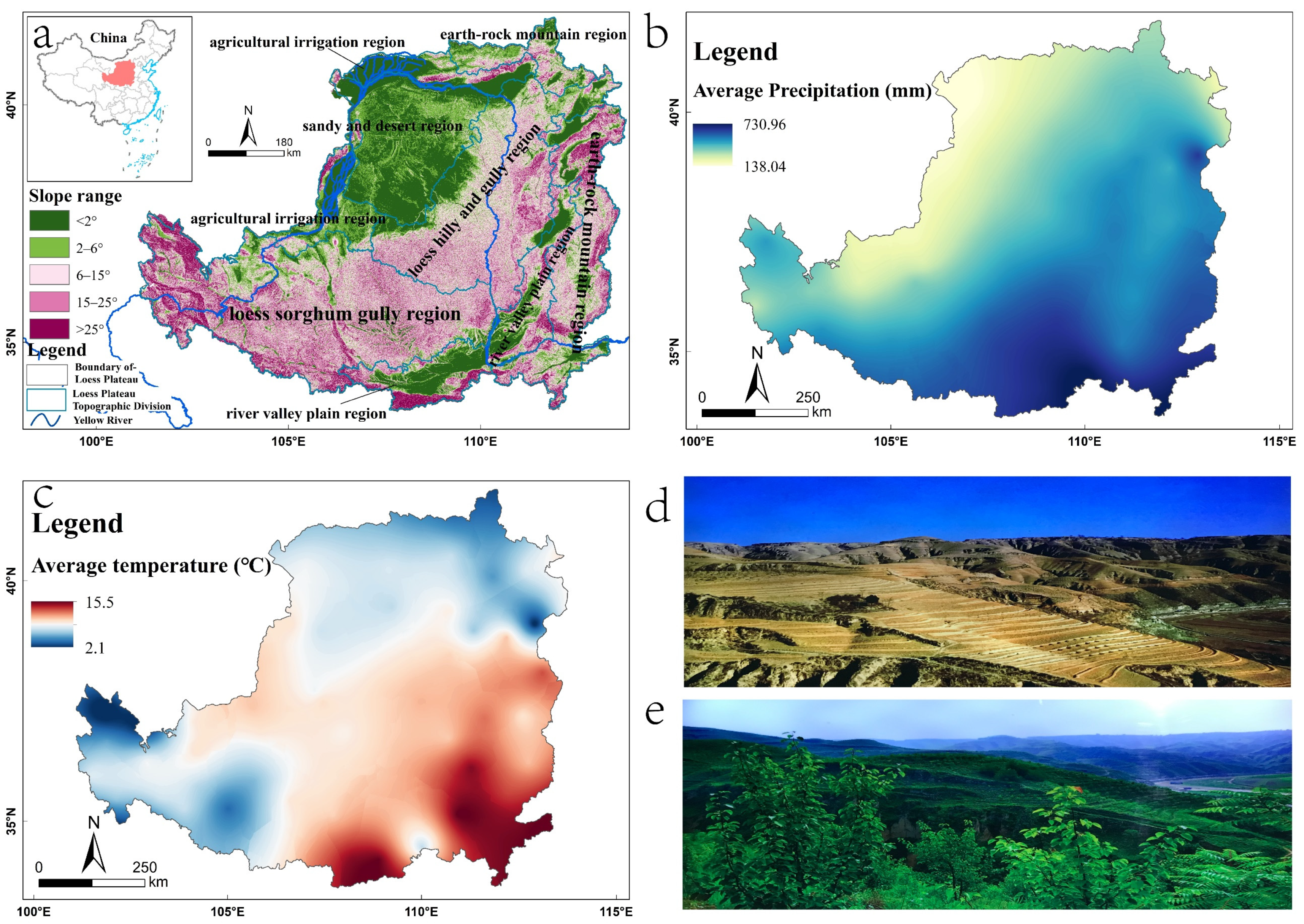
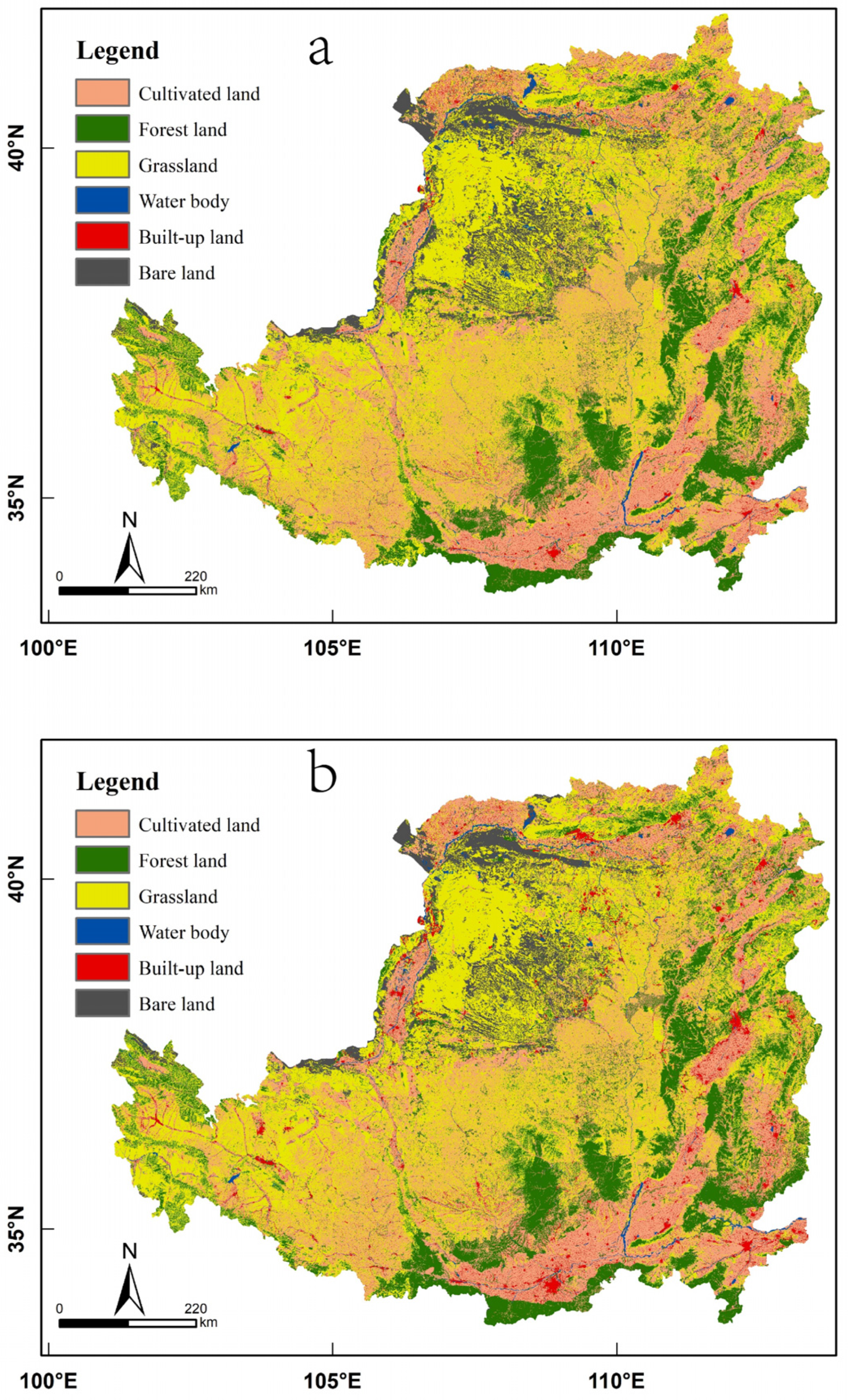
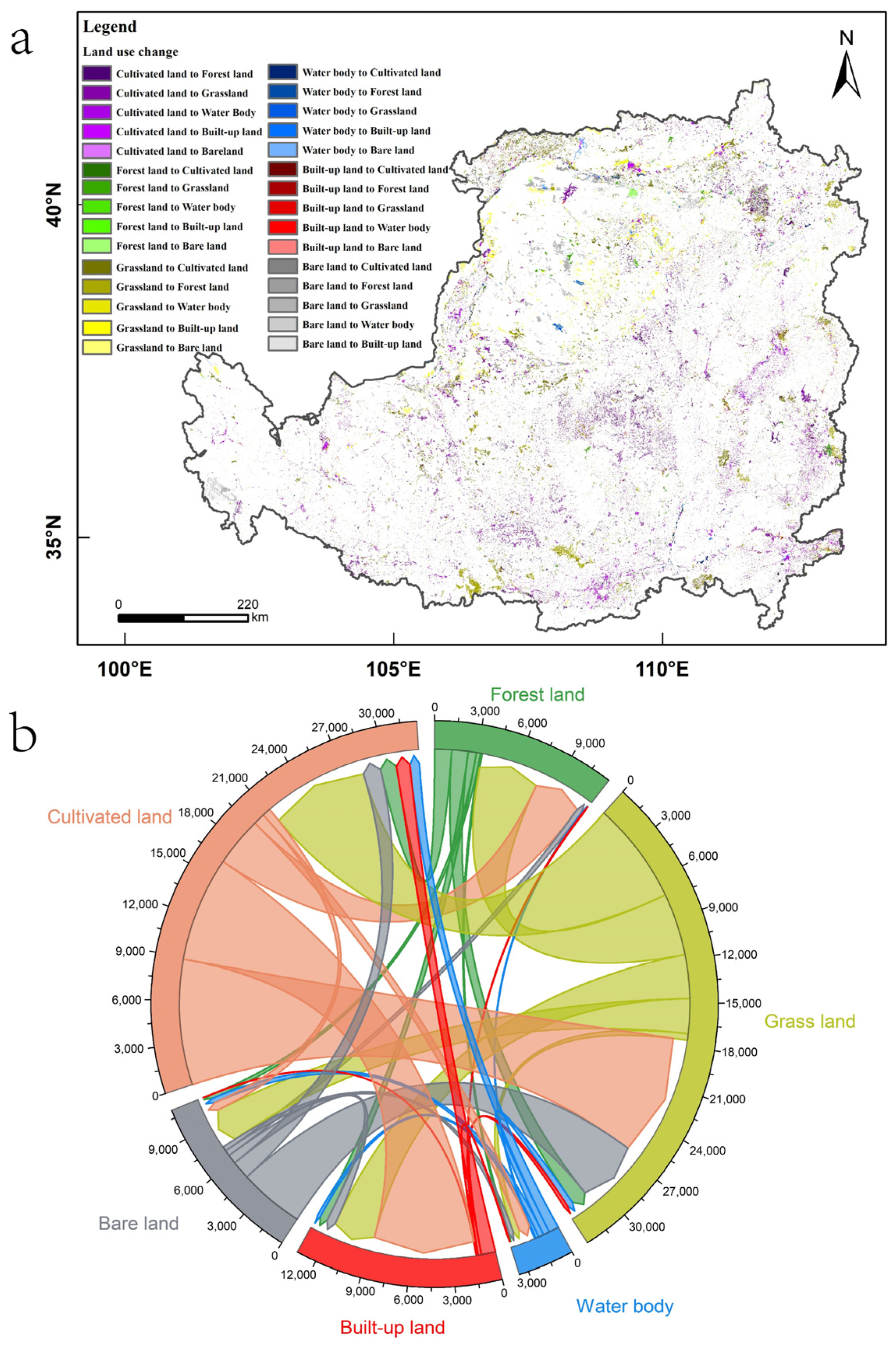
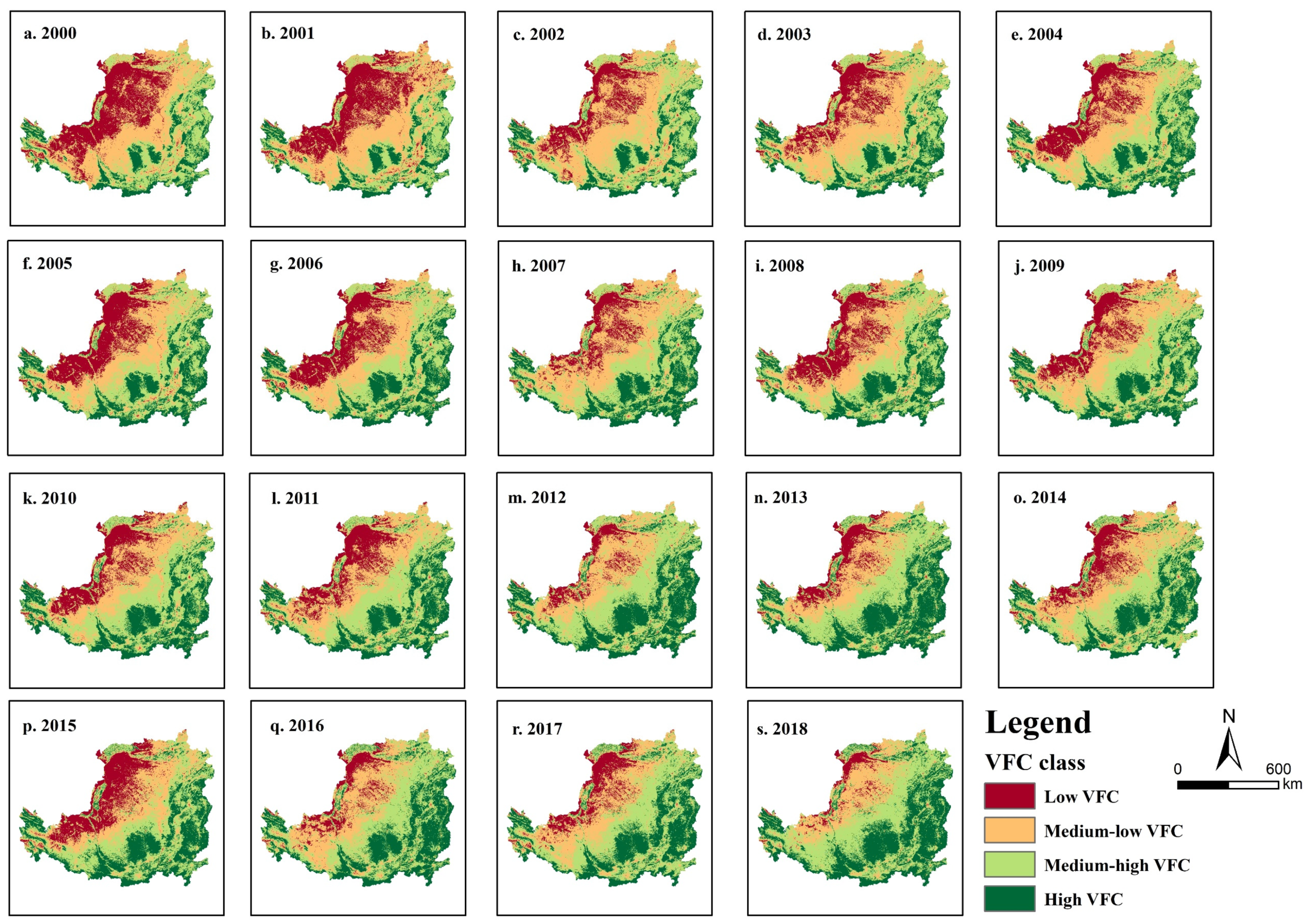
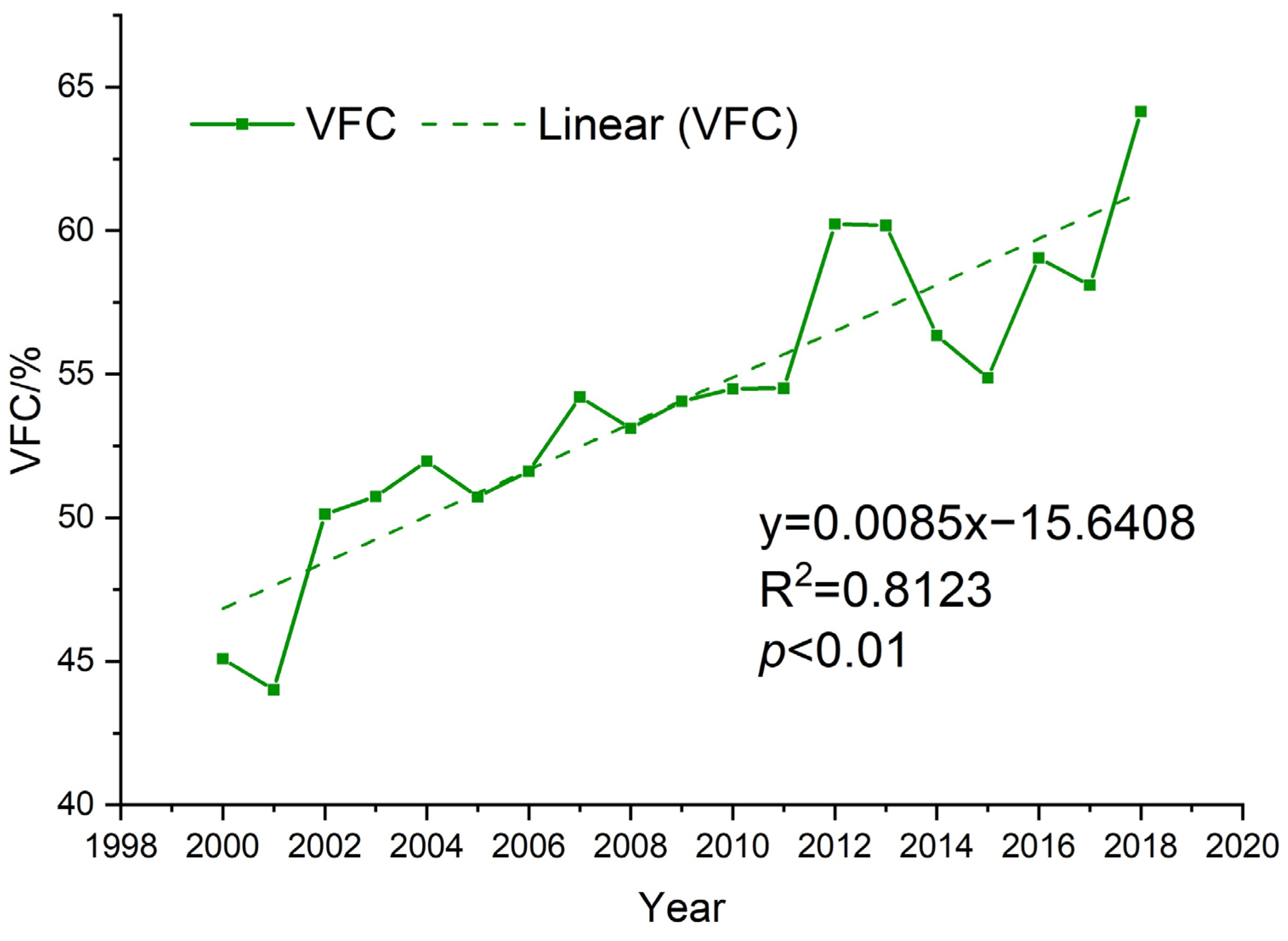
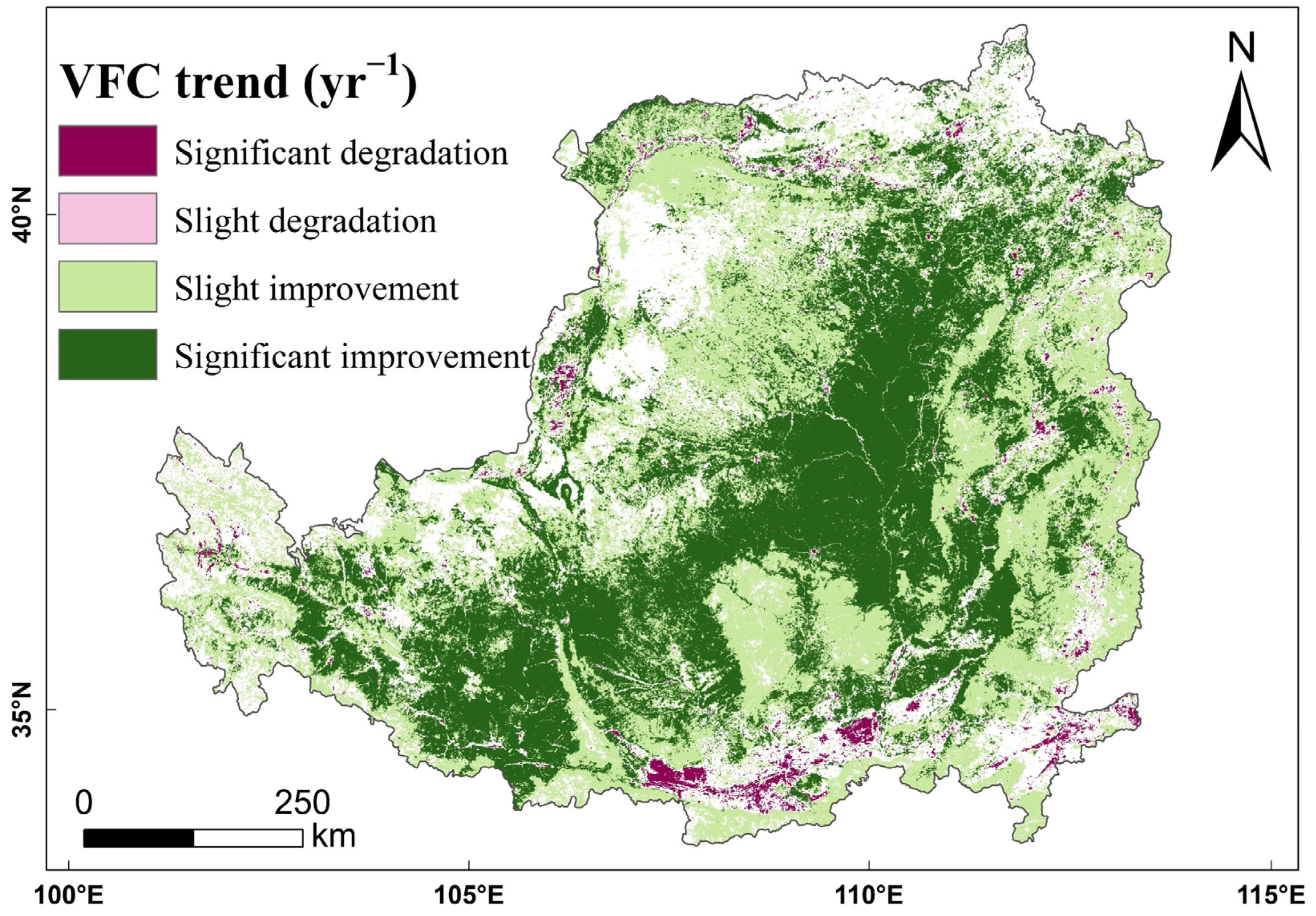
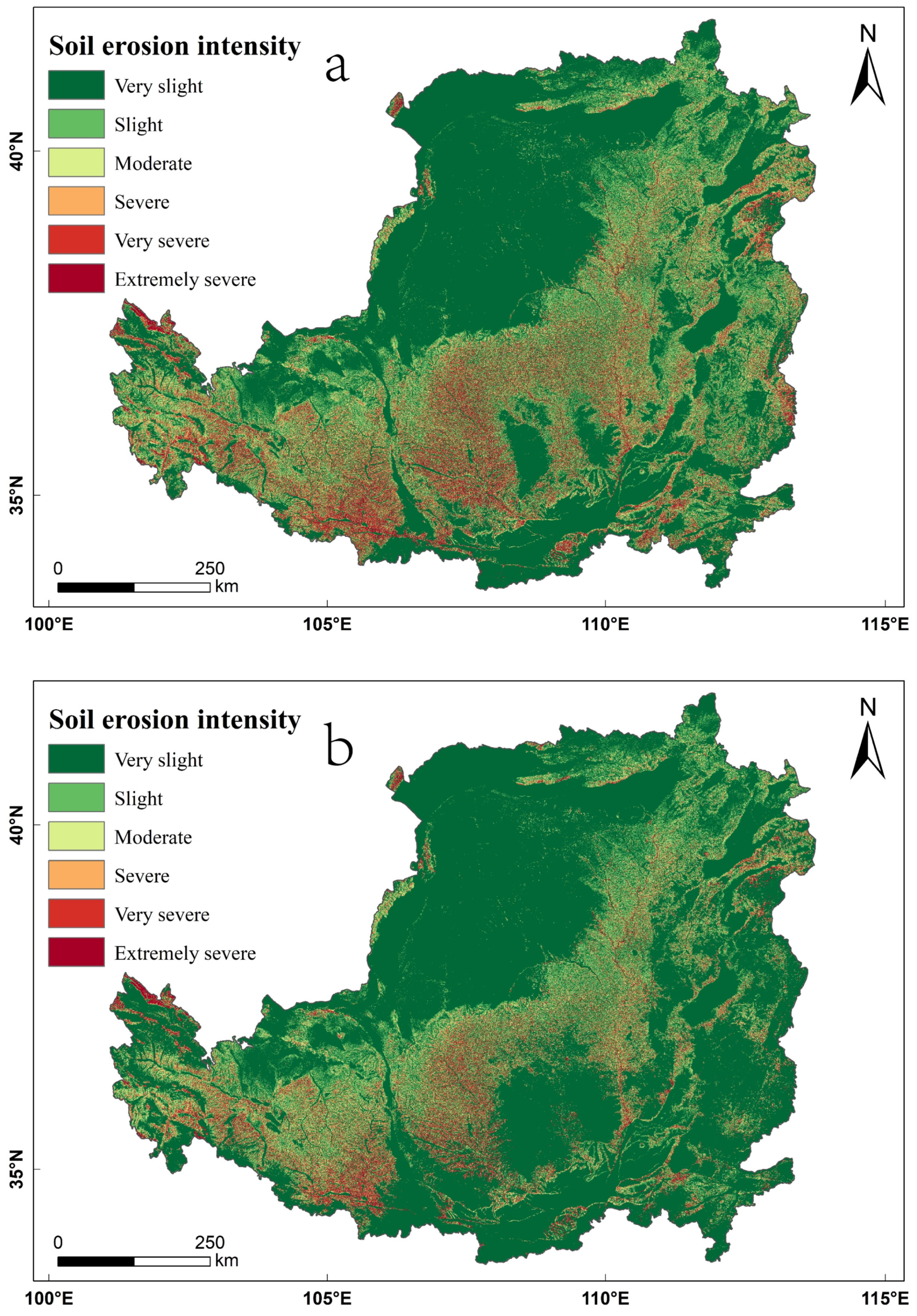
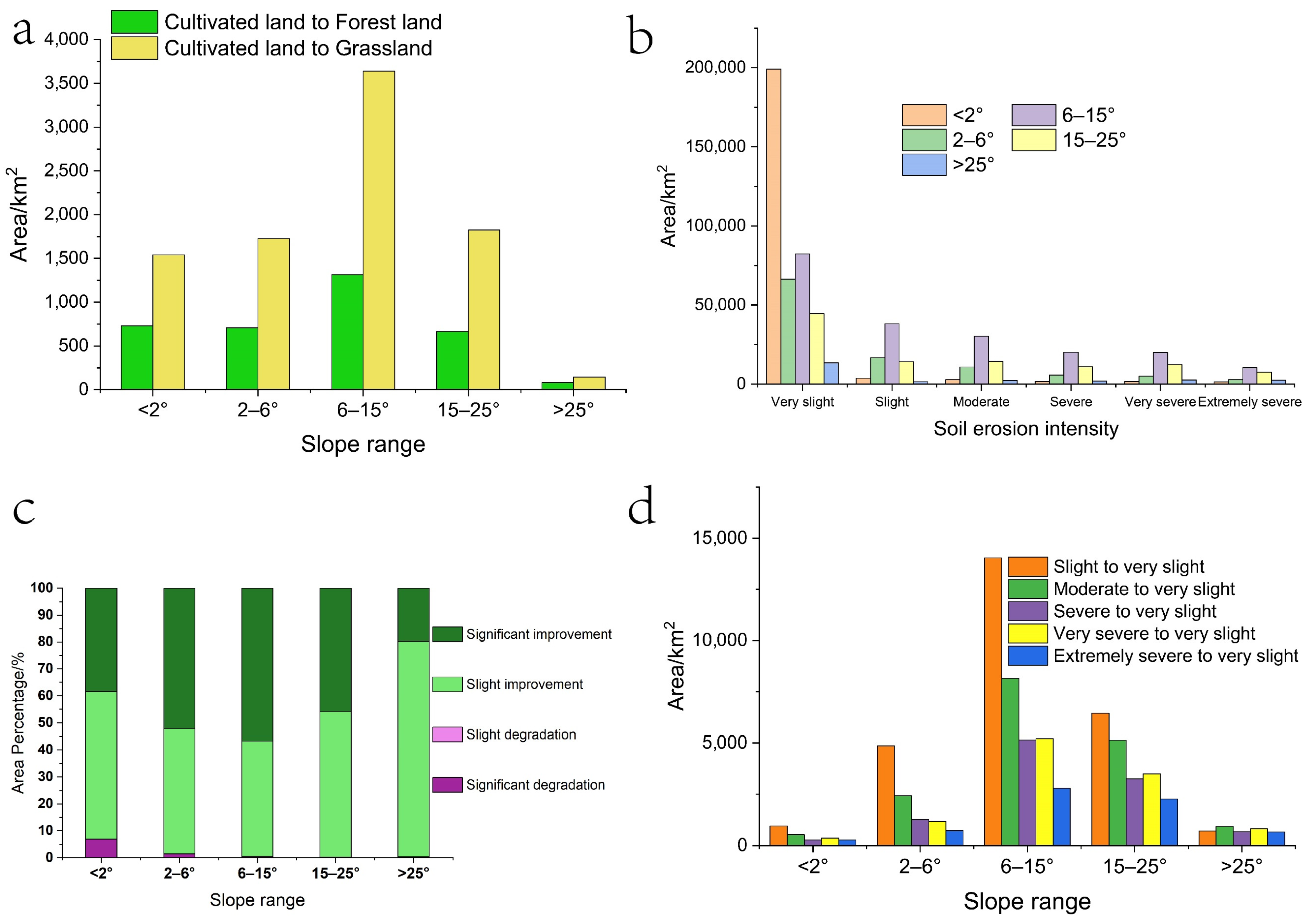
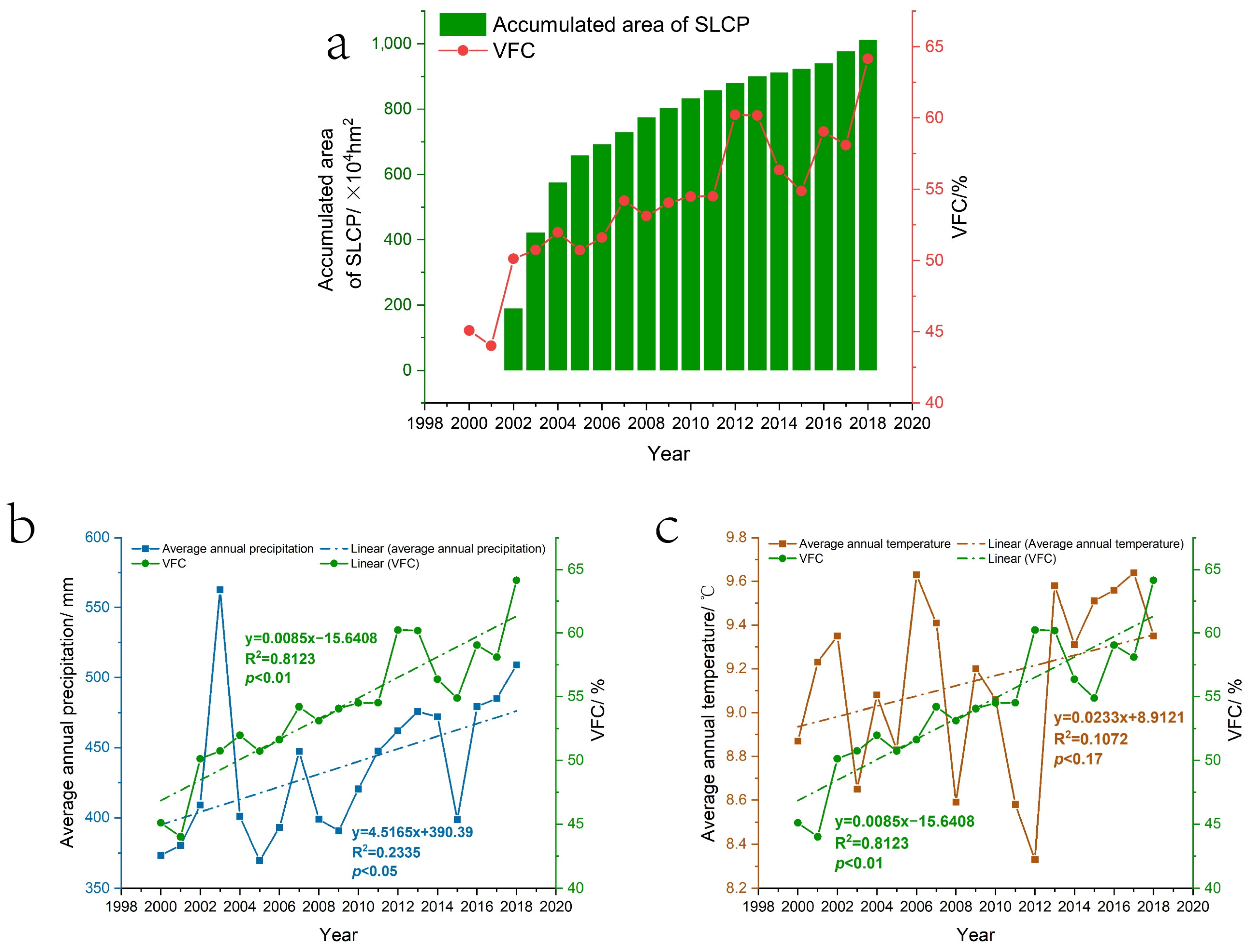
| Land Use Types | 2000 | 2018 | Change Rate(%/a) | ||
|---|---|---|---|---|---|
| Area | Proportion | Area | Proportion | 2000–2018 | |
| Cultivated land | 217,365.31 | 33.48% | 207,595.62 | 31.97% | −0.25 |
| Forest land | 104,521.47 | 16.10% | 109,614.19 | 16.88% | 0.27 |
| Grass land | 258,855.74 | 39.87% | 256,568.11 | 39.51% | 0.05 |
| Water body | 9178.82 | 1.41% | 9120.42 | 1.40% | 0.04 |
| Built-up land | 16,072.09 | 2.48% | 26,626.24 | 4.10% | 3.65 |
| Bare land | 43,300.14 | 6.67% | 39,769.35 | 6.13% | 0.45 |
| VFC Class | 2000 | 2018 | Change Rate (%) | ||
|---|---|---|---|---|---|
| Area | Proportion | Area | Proportion | 2000–2018 | |
| Low VFC | 159,619 | 24.58% | 31,105.5 | 4.79% | −19.79 |
| Medium-low VFC | 224,146.5 | 34.52% | 127,895.25 | 19.70% | −14.82 |
| Medium-high VFC | 172,117 | 26.51% | 263,168.75 | 40.53% | 14.02 |
| High VFC | 93,394.75 | 14.38% | 227,107.75 | 34.98% | 20.59 |
| Erosion Intensity | 2000 | 2018 | Change Rate (%) | ||
|---|---|---|---|---|---|
| Area | Proportion | Area | Proportion | 2000–2018 | |
| Very slight | 405,692 | 62.68% | 476,267.75 | 73.59% | 10.90 |
| Slight | 74,540 | 11.52% | 54,129 | 8.36% | −3.15 |
| Moderate | 60,586 | 9.36% | 45,374.75 | 7.01% | −2.35 |
| Severe | 40,192.5 | 6.21% | 29,211.5 | 4.51% | −1.70 |
| Very severe | 41,733.5 | 6.45% | 27,808 | 4.30% | −2.15 |
| Extremely severe | 24,485.25 | 3.78% | 14,439.25 | 2.23% | −1.55 |
| Erosion Intensity | Very Slight | Slight | Moderate | Severe | Very Severe | Extremely Severe |
|---|---|---|---|---|---|---|
| Very slight | 99.49% | 0.18% | 0.21% | 0.06% | 0.04% | 0.02% |
| Slight | 36.25% | 61.56% | 0.89% | 0.81% | 0.40% | 0.08% |
| Moderate | 28.36% | 10.67% | 59.10% | 0.75% | 0.64% | 0.48% |
| Severe | 26.41% | 1.25% | 17.67% | 52.99% | 0.91% | 0.76% |
| Very severe | 26.53% | 1.10% | 1.61% | 15.03% | 54.48% | 1.25% |
| Extremely severe | 27.56% | 0.43% | 1.20% | 1.38% | 15.69% | 53.74% |
Publisher’s Note: MDPI stays neutral with regard to jurisdictional claims in published maps and institutional affiliations. |
© 2022 by the authors. Licensee MDPI, Basel, Switzerland. This article is an open access article distributed under the terms and conditions of the Creative Commons Attribution (CC BY) license (https://creativecommons.org/licenses/by/4.0/).
Share and Cite
Deng, Y.; Jia, L.; Guo, Y.; Li, H.; Yao, S.; Chu, L.; Lu, W.; Hou, M.; Mo, B.; Wang, Y.; et al. Evaluation of the Ecological Effects of Ecological Restoration Programs: A Case Study of the Sloping Land Conversion Program on the Loess Plateau, China. Int. J. Environ. Res. Public Health 2022, 19, 7841. https://doi.org/10.3390/ijerph19137841
Deng Y, Jia L, Guo Y, Li H, Yao S, Chu L, Lu W, Hou M, Mo B, Wang Y, et al. Evaluation of the Ecological Effects of Ecological Restoration Programs: A Case Study of the Sloping Land Conversion Program on the Loess Plateau, China. International Journal of Environmental Research and Public Health. 2022; 19(13):7841. https://doi.org/10.3390/ijerph19137841
Chicago/Turabian StyleDeng, Yuanjie, Lei Jia, Yajun Guo, Hua Li, Shunbo Yao, Liqi Chu, Weinan Lu, Mengyang Hou, Binbin Mo, Yameng Wang, and et al. 2022. "Evaluation of the Ecological Effects of Ecological Restoration Programs: A Case Study of the Sloping Land Conversion Program on the Loess Plateau, China" International Journal of Environmental Research and Public Health 19, no. 13: 7841. https://doi.org/10.3390/ijerph19137841
APA StyleDeng, Y., Jia, L., Guo, Y., Li, H., Yao, S., Chu, L., Lu, W., Hou, M., Mo, B., Wang, Y., Yang, H., & Zhang, T. (2022). Evaluation of the Ecological Effects of Ecological Restoration Programs: A Case Study of the Sloping Land Conversion Program on the Loess Plateau, China. International Journal of Environmental Research and Public Health, 19(13), 7841. https://doi.org/10.3390/ijerph19137841








